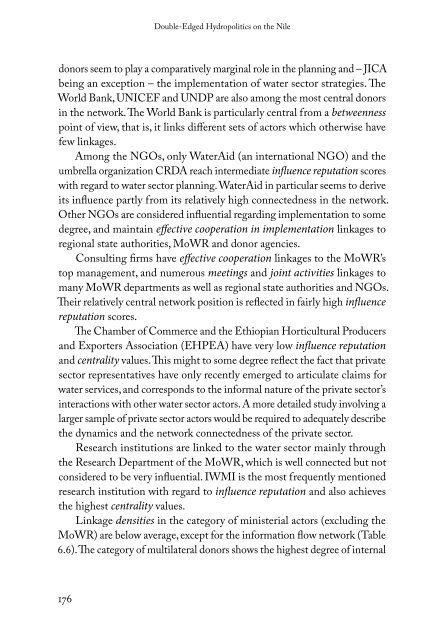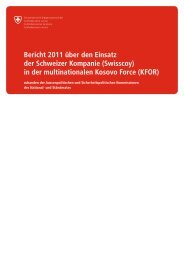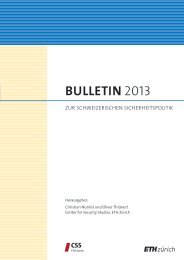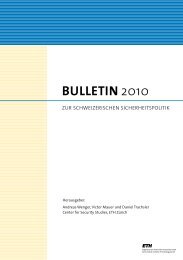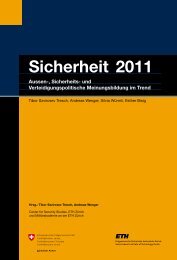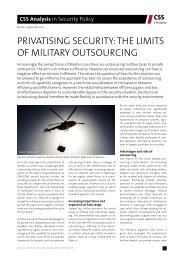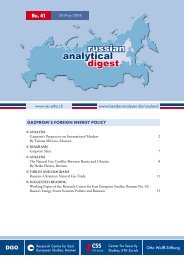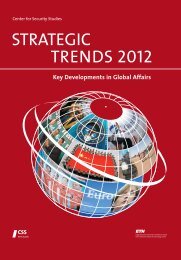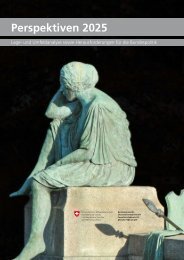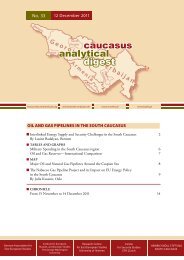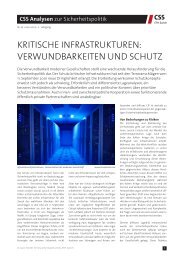Double-Edged Hydropolitics on the Nile - Center for Security Studies ...
Double-Edged Hydropolitics on the Nile - Center for Security Studies ...
Double-Edged Hydropolitics on the Nile - Center for Security Studies ...
Create successful ePaper yourself
Turn your PDF publications into a flip-book with our unique Google optimized e-Paper software.
<str<strong>on</strong>g>Double</str<strong>on</strong>g>-<str<strong>on</strong>g>Edged</str<strong>on</strong>g> <str<strong>on</strong>g>Hydropolitics</str<strong>on</strong>g> <strong>on</strong> <strong>the</strong> <strong>Nile</strong><br />
d<strong>on</strong>ors seem to play a comparatively marginal role in <strong>the</strong> planning and – JICA<br />
being an excepti<strong>on</strong> – <strong>the</strong> implementati<strong>on</strong> of water sector strategies. The<br />
World Bank, UNICEF and UNDP are also am<strong>on</strong>g <strong>the</strong> most central d<strong>on</strong>ors<br />
in <strong>the</strong> network. The World Bank is particularly central from a betweenness<br />
point of view, that is, it links different sets of actors which o<strong>the</strong>rwise have<br />
few linkages.<br />
Am<strong>on</strong>g <strong>the</strong> NGOs, <strong>on</strong>ly WaterAid (an internati<strong>on</strong>al NGO) and <strong>the</strong><br />
umbrella organizati<strong>on</strong> CRDA reach intermediate influence reputati<strong>on</strong> scores<br />
with regard to water sector planning. WaterAid in particular seems to derive<br />
its influence partly from its relatively high c<strong>on</strong>nectedness in <strong>the</strong> network.<br />
O<strong>the</strong>r NGOs are c<strong>on</strong>sidered influential regarding implementati<strong>on</strong> to some<br />
degree, and maintain effective cooperati<strong>on</strong> in implementati<strong>on</strong> linkages to<br />
regi<strong>on</strong>al state authorities, MoWR and d<strong>on</strong>or agencies.<br />
C<strong>on</strong>sulting firms have effective cooperati<strong>on</strong> linkages to <strong>the</strong> MoWR’s<br />
top management, and numerous meetings and joint activities linkages to<br />
many MoWR departments as well as regi<strong>on</strong>al state authorities and NGOs.<br />
Their relatively central network positi<strong>on</strong> is reflected in fairly high influence<br />
reputati<strong>on</strong> scores.<br />
The Chamber of Commerce and <strong>the</strong> Ethiopian Horticultural Producers<br />
and Exporters Associati<strong>on</strong> (EHPEA) have very low influence reputati<strong>on</strong><br />
and centrality values. This might to some degree reflect <strong>the</strong> fact that private<br />
sector representatives have <strong>on</strong>ly recently emerged to articulate claims <strong>for</strong><br />
water services, and corresp<strong>on</strong>ds to <strong>the</strong> in<strong>for</strong>mal nature of <strong>the</strong> private sector’s<br />
interacti<strong>on</strong>s with o<strong>the</strong>r water sector actors. A more detailed study involving a<br />
larger sample of private sector actors would be required to adequately describe<br />
<strong>the</strong> dynamics and <strong>the</strong> network c<strong>on</strong>nectedness of <strong>the</strong> private sector.<br />
Research instituti<strong>on</strong>s are linked to <strong>the</strong> water sector mainly through<br />
<strong>the</strong> Research Department of <strong>the</strong> MoWR, which is well c<strong>on</strong>nected but not<br />
c<strong>on</strong>sidered to be very influential. IWMI is <strong>the</strong> most frequently menti<strong>on</strong>ed<br />
research instituti<strong>on</strong> with regard to influence reputati<strong>on</strong> and also achieves<br />
<strong>the</strong> highest centrality values.<br />
Linkage densities in <strong>the</strong> category of ministerial actors (excluding <strong>the</strong><br />
MoWR) are below average, except <strong>for</strong> <strong>the</strong> in<strong>for</strong>mati<strong>on</strong> flow network (Table<br />
6.6). The category of multilateral d<strong>on</strong>ors shows <strong>the</strong> highest degree of internal<br />
176


